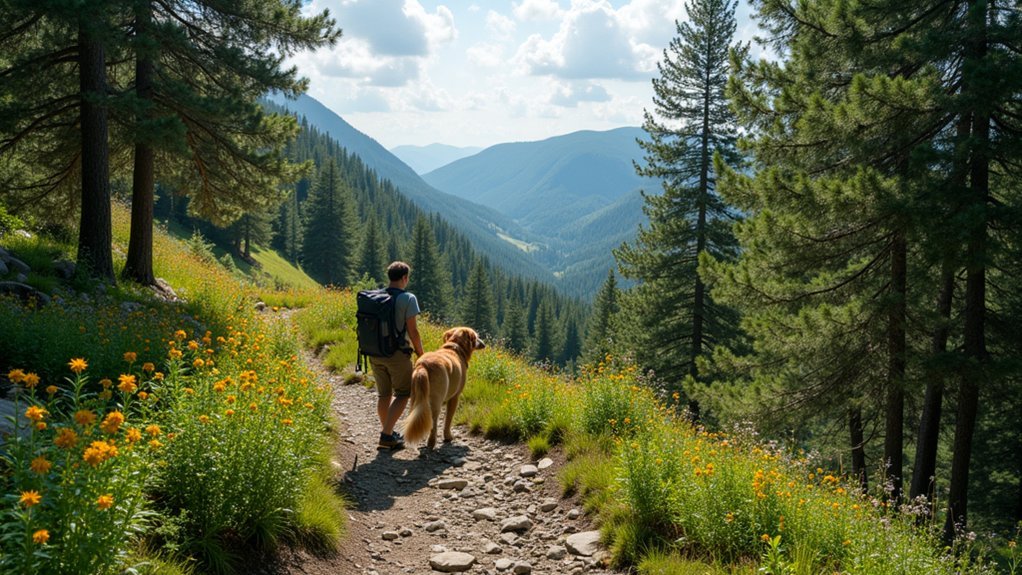Service dogs are welcome on many wilderness trails across America’s national parks, including Acadia, Shenandoah, Yosemite, Cuyahoga Valley, and Congaree. You’ll need essential gear like a proper harness, protective booties, portable water bowl, and first aid supplies for your canine companion. Always check specific park regulations before your trip, as ADA grants service animals broader access rights than pets. Proper preparation guarantees you’ll both enjoy safe, fulfilling nature experiences on trails that match your abilities.
Understanding Trail Classifications for Service Dog Handlers

Three main trail classifications—easy, moderate, and hard—serve as essential guides for service dog handlers planning outdoor adventures.
Easy trails offer flat, well-maintained paths with minimal obstacles, allowing you and your service dog to navigate comfortably while building confidence in outdoor settings.
Moderate trails present some elevation changes and rocky sections, requiring your service dog to maintain better fitness and training to assist you effectively.
Hard trails feature steep, rugged terrain that demands advanced skills and physical conditioning from both of you.
Before heading out, always research specific trail regulations and pet policies. Some trails restrict dog access or require leashes, even for service animals.
Understanding these classifications helps you select appropriate trails that match your service dog’s abilities and training level.
Essential Gear for Service Dogs on Wilderness Trails
Preparation and proper equipment guarantee your service dog remains safe, comfortable, and effective while accompanying you on wilderness trails. Equip your canine companion with a properly fitted harness that allows for easy leash attachment and displays identification clearly.
| Essential Gear | Purpose |
|---|---|
| Harness & Leash | Security and control on challenging trail sections |
| Portable Water Bowl | Hydration access even in remote wilderness areas |
| Protective Booties | Paw protection from sharp rocks and rough terrain |
| First Aid Kit | Treatment for injuries encountered on the trail |
Don’t forget to pack a collapsible water container to keep your service dog hydrated throughout your adventure. A reflective vest enhances visibility during low-light conditions, ensuring your service dog remains visible to you and other hikers on wilderness trails.
Accessible Wilderness Trails With Service Dog Amenities

While exploring the wilderness with your service dog may seem challenging, numerous national parks across the United States offer accessible trails designed with service animal needs in mind.
Acadia and Shenandoah welcome service dogs on all trails, ensuring you’ll never miss spectacular views together.
At Yosemite, you can navigate developed areas, paved roads, and scenic viewpoints with your service companion.
Cuyahoga Valley National Park boasts over 100 miles of scenic trails open to service dogs, though they’re restricted from certain buildings.
Don’t miss Congaree’s 2.4-mile Boardwalk Loop trail, which guides you and your service dog through magnificent old growth bottomland hardwood forest.
Most National Parks require service dogs remain leashed (maximum 6 feet) while hiking, protecting both wildlife and your companion while enjoying these wilderness areas.
Nature Therapy Benefits for Handlers and Service Dogs
Beyond the accessible trails themselves lies a powerful healing force that benefits both handlers and their service dogs. When you explore dog-friendly hiking trails, you’re actually engaging in nature therapy that greatly reduces stress levels for both you and your companion. Your cortisol levels drop while your service dog enjoys stimulating sensory experiences in diverse natural settings.
The best dog-friendly trails offer more than just outdoor adventure—they provide a pathway to improved emotional well-being. As you hike together, you’ll both gain physical fitness benefits while strengthening your unique bond.
Your service dog will practice skills in new environments, building confidence and enhancing performance. Meanwhile, you’ll experience mental health improvements as natural surroundings create a calming atmosphere that promotes mindfulness and relaxation—especially valuable if you’re managing disabilities or chronic conditions.
Navigating Legal Rights on Federal and State Parklands

Your access rights as a service dog handler differ considerably from those of regular pet owners, with federal laws generally permitting your team in areas where pets are prohibited.
You’ll need to familiarize yourself with the Americans with Disabilities Act provisions that apply specifically to parklands, including leash requirements and permitted areas.
Each park may have unique regulations based on conservation needs or safety concerns, so always check park-specific guidelines before planning your visit.
Know Your Access Rights
Understanding where you can legally take your service dog on trails can make the difference between a stress-free outing and an uncomfortable confrontation.
The ADA grants service animals considerably broader access rights than pets, especially in national parks where your service dog can accompany you on all public trails, while pets may face restrictions.
- Service dogs vs. pets – Your service dog has access to all public areas in national parks, unlike pets which are often limited to developed areas and certain trails.
- Leash requirements – Keep your service dog leashed (maximum six feet) and under control at all times for everyone’s safety.
- Communication is key – Inform park staff about your service animal upon arrival to facilitate smooth access and proper compliance with park regulations.
Always check specific state park policies, as regulations can vary between different park systems.
Park-Specific Guidelines Matter
While federal ADA laws provide broad protection for service dog access, traversing the specific guidelines of different park systems requires additional preparation.
National parks generally allow service animals in all areas, whereas pets face restricted access to many trails and wilderness zones.
Before visiting, research park-specific guidelines as regulations vary greatly. Most parks enforce 6-foot leash requirements for all dogs, including service animals.
State parks often mirror national park policies but may have unique restrictions for certain trails or facilities.
Although service animals don’t legally require identification, carrying documentation of your dog’s training can prevent misunderstandings with park staff. This is especially helpful when accessing areas with pet restrictions.
Remember that even service animals may face limitations in particularly sensitive wilderness zones, so always check individual park regulations before your visit.
Safety Protocols for Service Dogs in Wilderness Settings
Because wilderness trails present unique challenges, maintaining proper safety protocols for service dogs is vital for an enjoyable outdoor experience.
Always keep your service dog under control with a leash or harness, especially in wilderness areas where wildlife encounters are possible. Verify area-specific regulations before your adventure, as some trails have restrictions even for service animals.
Leash control is non-negotiable in wilderness settings where unexpected wildlife interactions could endanger both dog and handler.
Your well-trained companion must be prepared to navigate diverse terrain types safely while remaining responsive to your commands.
Consider these critical safety measures:
- Confirm proper identification with service dog vests or harnesses
- Pack supplies for environmental hazards including extreme weather, water crossings, and first aid
- Practice wildlife encounter protocols with your handler team before venturing into remote areas
Seasonal Considerations for Service Dog Trail Adventures
As the seasons change throughout the year, you’ll need to adapt your service dog trail adventures accordingly.
Winter snow and spring rains can create muddy trail conditions requiring waterproof gear for both you and your service dog.
During summer months, prioritize hydration and schedule hikes during cooler morning or evening hours to prevent overheating.
Fall offers stunning foliage but comes with increased trail traffic, which may distract your working companion. Be mindful of falling leaves that can trigger allergens affecting your dog’s performance.
Spring wildflower hikes provide beautiful scenery, but remain alert for heightened wildlife activity that could challenge your service dog’s focus. Seasonal allergens are also prevalent during this time.
Always check park-specific regulations before heading out, as some wilderness zones have restrictions even for service dogs.
Community Resources and Support Networks for Accessible Hiking
Finding suitable trails for you and your service dog doesn’t have to be a solo journey. Community organizations offer valuable resources and support for accessible hiking adventures, connecting you with fellow service dog handlers and experienced outdoors enthusiasts.
- Local meetups and group hikes – Join service dog communities that organize regular trail outings, providing safety in numbers and shared knowledge about trail conditions.
- Digital resources – Utilize specialized mobile apps and park websites that feature dog-friendly trails with user reviews highlighting accessibility features specific to service dog needs.
- Advocacy connections – Connect with local advocacy groups working with park services to improve trail accessibility, as they often maintain updated information about newly enhanced facilities and can recommend the most accommodating outdoor spaces.
Frequently Asked Questions
Are Service Dogs Allowed on Hiking Trails?
Yes, service dogs are allowed on hiking trails under the ADA. You’ll need to keep your dog leashed, maintain control, and may need documentation of their training when requested by park officials.
Has Anyone Done the PCT With a Dog?
Yes, people have completed the PCT with dogs, though you’ll need to plan carefully for restricted areas in national parks. You’ll face challenges with water access and must follow leash laws throughout the journey.
Can a Dog Go on a 10 Mile Hike?
Yes, many dogs can handle a 10-mile hike, but it depends on their fitness, breed, and age. You’ll need to build their endurance gradually, guarantee proper hydration, and watch for signs of fatigue.
What Is the Most Dog Friendly National Park?
Acadia National Park is the most dog-friendly national park. You’ll find over 100 miles of hiking paths where your dog can join you on most trails and carriage roads with a 6-foot leash.
In Summary
You’ve now got the tools to explore the great outdoors with your service dog partner. Remember to plan ahead, pack appropriately, and know your rights. Whether you’re seeking therapeutic benefits or adventure, these accessible trails welcome your working team. Connect with fellow service dog handlers for support, and always prioritize your dog’s safety in changing wilderness conditions. Happy trails await you both!





Leave a Reply